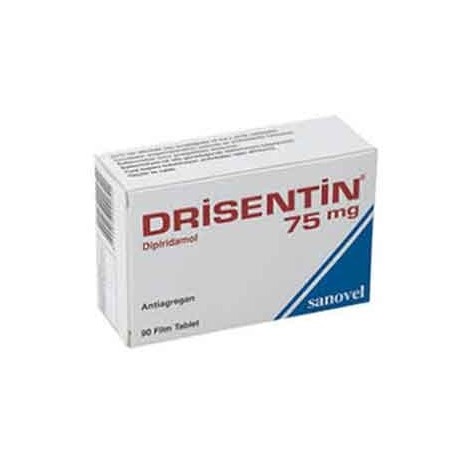 View larger
View larger Drisentin Dipyridamole Aspirin (aggrenox,persantine) 75 Mg 90 Tablets
DRSN9901
New product
BUY MORE PAY LESS
| Quantity | Discount | |
|---|---|---|
| 2 | 5% | |
| 3 | 10% | |
| 4 | 15% | |
| 5 | 20% |
Volume discounts
| Quantity | Discount | You Save |
|---|---|---|
| 2 | 5% | Up to $3.40 |
| 3 | 10% | Up to $10.20 |
| 4 | 15% | Up to $20.40 |
| 5 | 20% | Up to $34.00 |
More info
. CLINICAL FEATURES
4.1. Therapeutic indications
DRISENTIN is indicated for the prevention of postoperative thromboembolic complications of heart valve replacement in combination with coumarin anticoagulants.
4.2. Posology and method of administration
Posology / application frequency and duration:
The recommended dose is 75 mg (1 dragee) 3 or 4 times a day.
Method of Application:
DRISENTIN is taken orally. The drug should be used on an empty stomach before meals.
Additional information on special populations:
Kidney failure:
Data are not available.
Liver failure:
It is recommended not to limit the dose of dipyridamole unless liver failure has been clinically proven.
Pediatric population:
The efficacy and safety of DRISENTIN in children under the age of 12 is unknown.
4.3. Contraindications
It is contraindicated in those who are hypersensitive to any of the ingredients of the product.
4.4. Special use warnings and precautions
Among other things, dipyridamole acts like a vasodilator. It should be used with caution in patients with unstable angina and / or a recent heart attack, severe cardiovascular disease, including left ventricular outflow obstruction or hemodynamic instability (decompensated heart failure, etc.).
In patients with myasthenia gravis, it may be necessary to adjust treatment following changes in dipyridamole dosage (see Drug Interactions).
DRISENTIN should be used with caution in patients with coagulation disorders.
Unconjugated dipyridamole, which has been shown to be included in gallstones of different sizes (up to 70% by dry weight of the stone), has been reported in very few cases. All of these patients were elderly patients with rising signs of cholangitis who had been treated with oral dipyridamole for several years. There is no evidence that dipyridamole causes gallstones in these patients. However, bacterial deglucuronidation of conjugated dipyridamole in bile may be responsible for the presence of dipyridamole in gallstones.
It should be used with caution in patients planning to become pregnant, during pregnancy and lactation periods.
This medicinal product contains lactose. Patients with rare hereditary problems of galactose intolerance, the Lapp lactase deficiency or glucose-galactose malabsorption should not take this medicine.
This medicinal product contains less than 1 mmol (23 mg) sodium per dose; No sodium-related side effects are expected at this dose.
This medicinal product contains FD&C yellow No 6 dye, powder and ponceau 4R dye. May cause allergic reactions.
4.5. Interaction with other medicinal products and other forms of interaction
Dipyridamole increases the plasma levels and cardiovascular effects of adenosine. If it is required to be used with dipyridamole, the dose of adenosine should be adjusted.
There are findings regarding the effects of aspirin and dipyridamole that increase platelet motility.
Application of antacids can reduce the effect of DRISENTIN. There is a possibility that DRISENTIN can increase the effect of oral anticoagulants.
When dipyridamole is used in combination with anticoagulants and acetylsalicylic acid, intolerance and risks should be observed for these preparations. The addition of dipyridamole to acetyl salicylic acid does not increase the incidence of bleeding events. When dipyridamole is co-administered with warfarin, bleeding was not more frequent or severe than that observed with warfarin alone.
Dipyridamole may increase the hypotensive effect of drugs that lower blood pressure and inactivate the anticholinesterase effects of cholinesterase inhibitors, thus myasthenia gravis may be exacerbated.
It may increase the hypotensive effects of drugs that lower blood pressure.
4.6. Pregnancy and lactation
General advice
Pregnancy category: B
Women with childbearing potential / contraception (Contraception)
Data are not available.
Gestation period
There is insufficient evidence for its safety in pregnancy, but Dipyridamole has been used for years without any harmful effects. Animal studies have not shown harmful effects. The drug should not be used in pregnancy, especially in the first trimester, unless the expected benefit to the mother is more than the possible risk to the fetus (see Section 5.3).
Lactation period
Approximately 6% of the plasma concentration of dipyridamole is excreted in milk. Therefore, if it is thought that it should only be taken by a doctor, DRISENTIN should be used during lactation.
Reproductive ability / Fertility
There are no studies conducted on DRISENTIN to investigate its effects on human fertility.
Non-clinical studies with dipyridamole did not show direct or indirect harmful effects on fertility (see section 5.3).
4.7. Effects on ability to drive and use machines
Studies on the effects on the ability to drive and use machines have not been conducted.
However, patients should be informed that side effects such as dizziness may occur during dipyridamole therapy.

